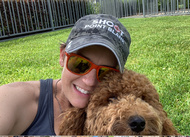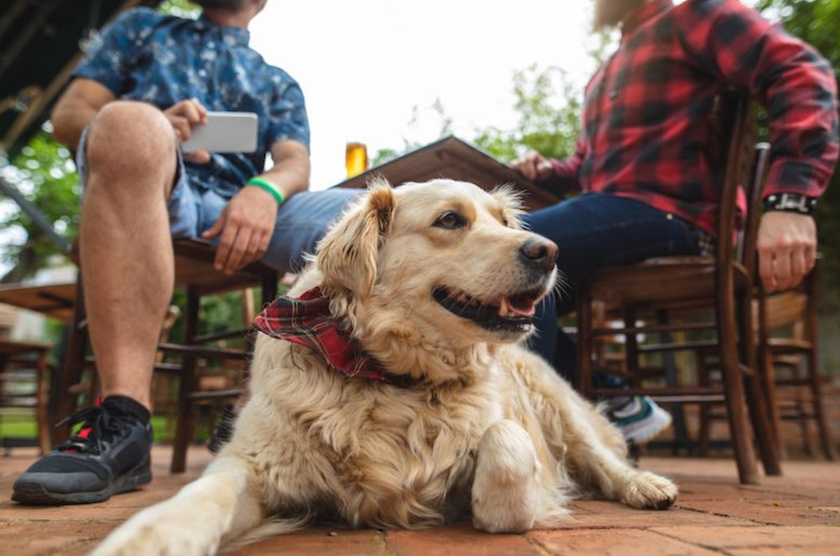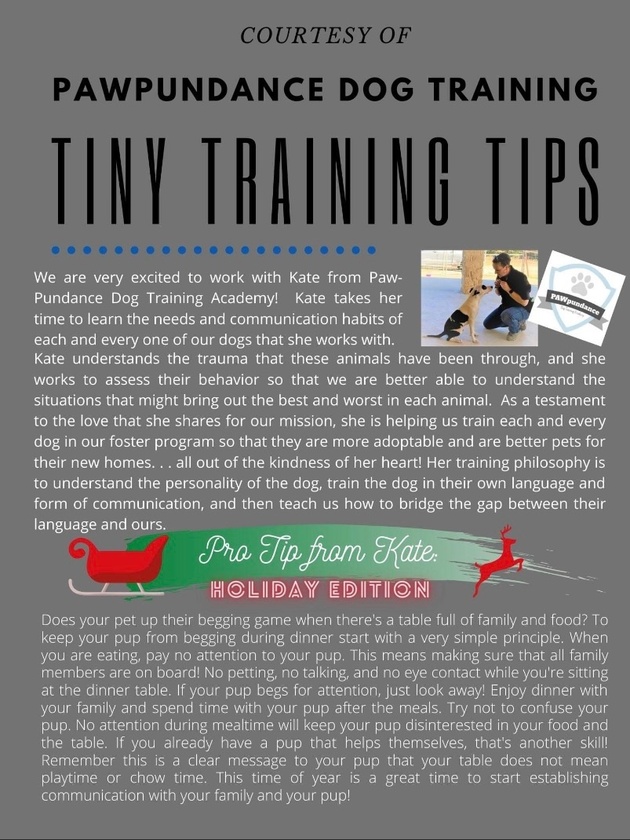
It’s ok! We’re here to help. We speak a little dog and can help translate for both of you. It’s probably just a miscommunication! And we are here to help get you both speaking the same language! Woof!
Connect with the PAWpundance training team and other members of the dog community to discuss better ways to communicate with your furry house guest.
**To get started USE code: TRIAL1month **
Impulse Control
What is impulse control? In its simplest form, it’s learning to pause. In a meditation course I attended, the teacher explained the calming benefits of learning to respond rather than react. This is the tool we aim to teach our pups. For a reactive dog facing fear, that momentary pause allows them a chance to choose how they want to respond rather than simply reacting.
There are many effective, science-based approaches to modifying a dog’s physiological response to triggers, such as CC&D (counter-conditioning and desensitization), BAT (behavior adjustment training), and CAT (constructional aggression treatment). However, if we aren’t working on impulse control and scent work (see our other article here…), then we may not be setting our pups up for success in stressful situations.
Impulse control activities are beneficial for a range of pups, including those who are reactive, excitable, or fearful. These activities provide tools to calm down during moments of panic, giving the dog a chance to understand and process their surroundings. Initially, it may just be a brief pause, but over time, they can build up to holding that calm for longer. Then we can start increasing distractions and even practicing from a greater distance. This progression is essential because there may be times when a pup needs to take that pause without us right next to them. By practicing impulse control in a familiar, safe environment, we’re preparing them for the outside world, helping them gain confidence to handle their fears.
Importantly, impulse control is not a replacement for behavior modification; rather, it enhances and supports it. Practicing these activities at home can make the time spent with a trainer even more effective, allowing the project to progress faster. Here are some situations where impulse control can make a difference: food reactivity or aggression, dog-on-dog aggression, and fears of bikes, scooters, or other moving objects.
When starting impulse control training, the first step is simply eye contact. This may seem basic, but it’s fundamental. I often work with the pup first to establish understanding, and then involve the human caregiver. This approach highlights that this is a two-part skill: not only does the pup need to understand the cues, but the human also needs to build “instructional control.” This is more than just about obedience—it’s about fostering a two-way conversation and creating mutual understanding.
For example, initial training with a puppy or rescue pup can feel a bit uncomfortable as they adjust. Training is truly about the relationship. When I meet a new dog, I assess eye contact early on. Dogs have their own culture around eye contact, often using it sparingly. Direct staring can feel threatening to them. Norwegian dog trainer Turid Rugaas coined the term “calming signals,” and a look-away is a polite gesture in “dog language,” communicating “hello” without confrontation.
We begin teaching dogs to make more frequent, gentle eye contact, which helps them succeed in the human world. This builds trust and opens a new avenue for dogs to get what they need from us. I start with a treat held near my nose, encouraging the dog to look at me, then rewarding a moment of eye contact with a clicker. Gradually, we scale up to longer eye contact.
When training, I avoid sunglasses and use my actual eyes to connect with the dog. For calm behavior, I wait not only for eye contact but also for the dog’s panting to stop, indicating they’re truly relaxed. This small detail teaches the human partner to observe the dog’s physical cues closely, so we move forward in sync with the dog’s needs and comfort level.
Once we establish calm eye contact and “instructional control,” we introduce the cues “stay” and “wait.” I use “stay” for holding a position until I return and “wait” for shorter pauses, like at doorways. These distinctions help clarify expectations without overwhelming the dog or caregiver, allowing for a smoother, less punitive learning experience.
The second skill—learning “wait”—challenges both dog and human. Humans learn to smile, ensuring they don’t intimidate the dog, and to read the dog’s body language for signs of readiness. Timing is everything here; the aim isn’t to follow a clock but to observe and respond to the pup’s cues.
As progress is made, we add distractions, which transitions “wait” to a more traditional “stay.” With a low-value treat in one hand and a high-value treat in the other, I start by encouraging eye contact, gradually moving the low-value treat further away as the dog learns to maintain their focus on me. With consistent practice, the goal is for the dog to resist the temptation to grab a treat placed right between their paws. Over time, this training becomes instinctual rather than a game of “who gets there first.”
If food excitement is a barrier, try using a toy as a distraction or placing food under your hand on the ground. When the dog realizes they can’t reach it, they’ll eventually look up at you, and you can click and reward for eye contact. Gradually, you can uncover the food and maintain eye contact without them breaking the “leave it” cue. Following the principle from Karen Pryor’s 10 laws of shaping, it’s best to end each session on a high note and quit while ahead, keeping confidence high.
Once “stay” is reliable, we add distance and duration in small increments, gradually increasing distractions. It may feel slow at first, but progress compounds. Working through cycles of duration, distraction, and distance will eventually yield a solid “stay” for a few minutes—even with you out of sight.
The next skill is “leave it,” which involves using body blocks. For example, if you drop something a dog shouldn’t eat, you can simply place your foot in front of it and say, “leave it.” Body blocks are rooted in dog communication; most dogs understand the physical presence as a boundary.
Finally, a reliable “leave it” allows us to test their impulse control with progressively harder challenges. If a dog sees a treat and can turn and walk away on cue, we know they’re mastering impulse control.
Training impulse control is about more than obedience; it’s about giving your dog the tools to manage their emotions in our world. It’s a partnership, and through careful, consistent practice, we can help our pups navigate life with confidence and calm.
Welcome to PAWpundance Dog Training Academy on Locals.com!
We’re thrilled that you’ve joined our community! PAWpundance is a place for positive, dog-loving people to come together, share experiences, and help each other grow. Locals offers an “ad-free experience,” so even a small contribution helps support our tech and keeps our community thriving.
We want to see your furbabies!
We’re here to assist with any questions you may have about training, behavior, and more. At PAWpundance, we believe in blending knowledge with a bit of fun—expect plenty of paws, puns, and maybe even a dance or two! Together, let’s enjoy some laughs and build stronger relationships with our pups.
Our Philosophy:
We’ve invited another species to live in our homes, and our dogs are much more than accessories; they’re our guests. They don’t speak our language, and like in the movie E.T., we don’t want to be the intimidating figures trying to coerce a scared, confused being. Instead, we want to be like ...
Eye Contact, Eye Contact, Eye Contact!
Reward every glance. Start by reinforcing brief glances, then encourage your pup to hold your gaze a bit longer. Gradually phase out your part of the eye contact—your pup will learn to watch you and adapt to your movements naturally. This approach helps them learn to walk with you without relying on leash cues.
Remember, the leash is purely for safety—not for communication.
Take a look at this video with Meghan and Buckee. Buckee is watching Meghan closely, and she rewards him by making eye contact, smiling, and offering treats. Meghan also looks forward occasionally, teaching Buckee to walk with her in sync.
Notice that Buckee is a reactive pup, so the leash is essential for safety, especially if he responds to something unexpectedly. However, it’s only used for physical control when necessary. When Buckee refocuses, Meghan reestablishes instructional control, and they continue their walk together. She does a fantastic job of engaging with him! In ...
Loose-Leash Walking Tip:
Where you reward makes a big difference! Try using the hand on the same side as your dog when giving treats or praise.
When you reach across your body to reward with the opposite hand, it draws your dog’s nose in front of you, encouraging them to move ahead and potentially start pulling.
In the video of Meghan and Domino, Meghan holds the leash with her left hand while Domino walks on her right. She rewards him by petting and giving treats with her right hand. This keeps Domino walking by her side on a loose leash, rather than in front, pulling her along.
Next time you’re out walking with your pup, try rewarding with the hand on the same side as your dog.
https://twitter.com/wholedogjournal/status/1295508215740932098?s=21
How to teach you pup to be a good dining companion! What a great skill!

https://twitter.com/wholedogjournal/status/1292609106637987840?s=21
This is about counter-surfers, but I love the description of trying to shame dogs. This author, Pat Miller helped me understand this concept in her book the Power of Positive Dog Training.
If you’re still on Twitter, the Whole Dog Journal is a great group to follow. Lots of fantastic info!













